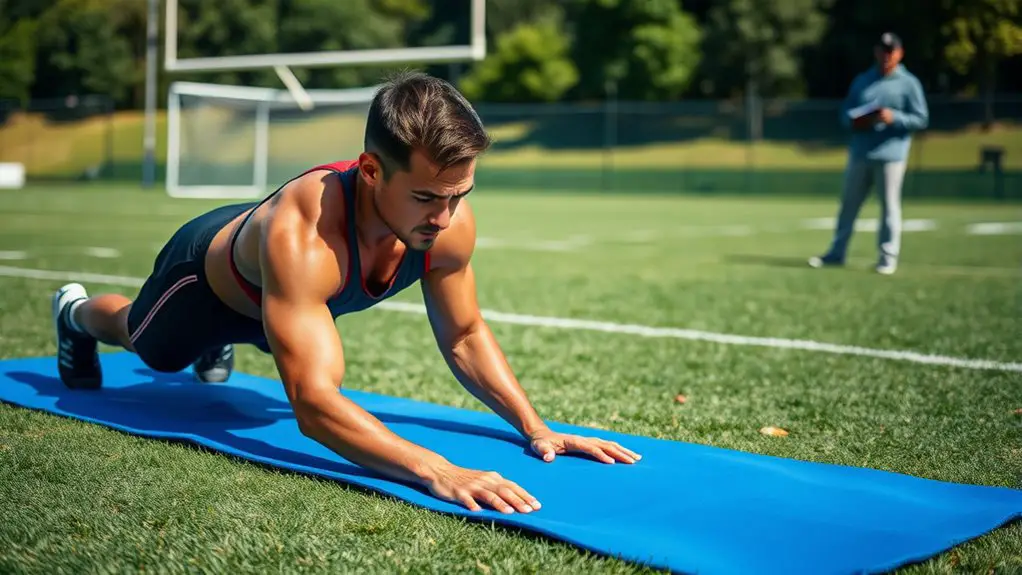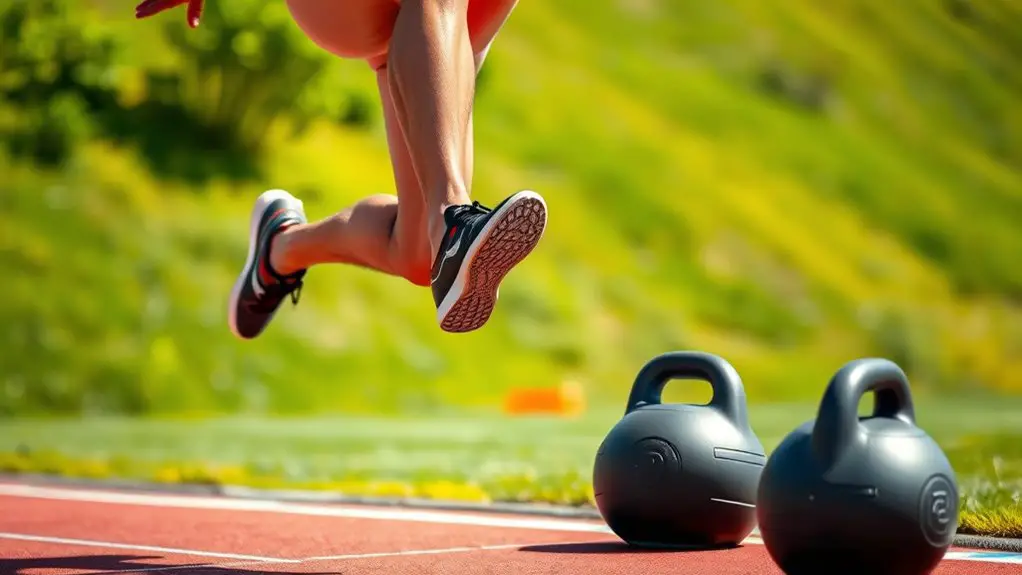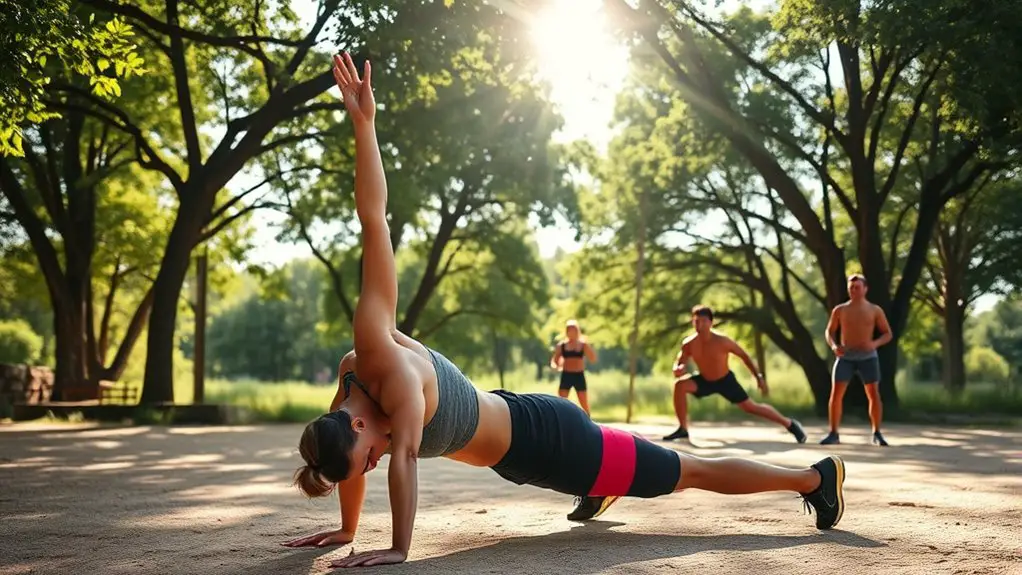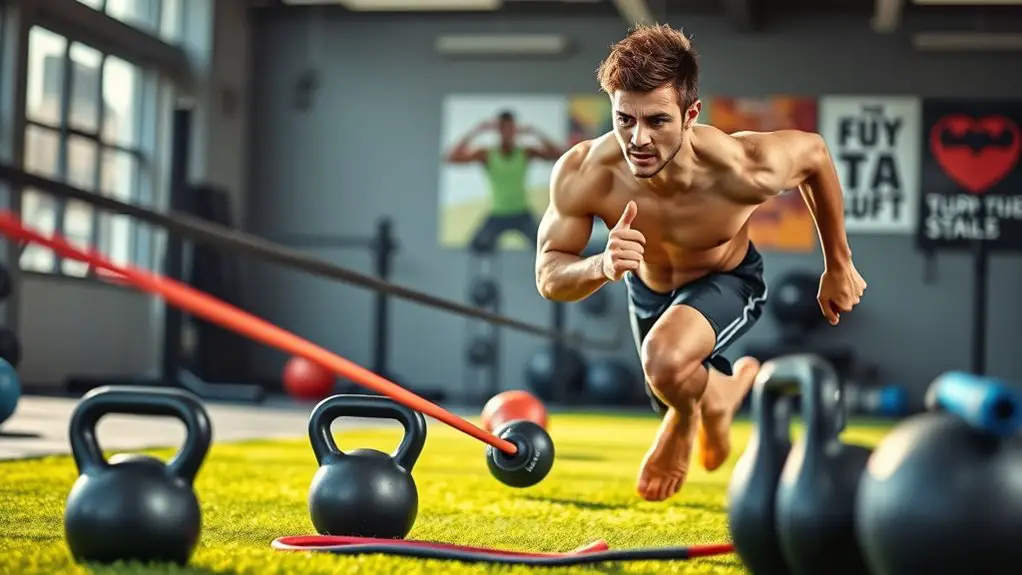To build a stronger core for football stability, focus on exercises like planks, Russian twists, and medicine ball throws. These will enhance stability and power during plays. Incorporate balance training using stability balls or single-leg stands to improve coordination. Don't forget the importance of flexibility and proper nutrition; lean proteins and whole grains support muscle recovery. Staying hydrated boosts overall performance. For a thorough workout plan and more tips, you'll find valuable insights ahead.
Understanding Core Muscles and Their Role in Football
The core is the powerhouse of your body, playing an indispensable role in nearly every movement on the football field. Understanding core muscle anatomy is fundamental for any athlete seeking freedom of movement and stability. Your core isn't just about abs; it includes the muscles in your lower back, hips, and pelvis, all working together.
These muscles provide stability during explosive actions like sprinting, cutting, or tackling. Core muscle function is critical for maintaining balance and posture, allowing you to perform at your best. When you engage these muscles properly, you enhance your agility and strength, empowering you to dodge opponents and make those game-winning plays. A strong core not only supports your body's mechanics but also plays a crucial role in preventing injuries, reducing the risk of injury and optimizing your performance. So, take the time to learn and train these indispensable muscles, and you'll experience the freedom to move with confidence on the field.
Benefits of a Strong Core for Athletes
While many athletes focus on building strength and speed, they often overlook the essential benefits that a strong core provides. Core strength is the foundation of athletic performance, enhancing balance, stability, and coordination. When your core is solid, you can transfer power more efficiently through your limbs, which can lead to explosive movements and a competitive edge on the field.
Moreover, a strong core helps prevent injuries by stabilizing your body during intense activities. It supports your spine and reduces the risk of strains, allowing you to train harder and longer without setbacks. You'll also find that improved core strength aids in your agility, enabling quicker direction changes and better overall movement. Additionally, incorporating mobility training into your routine can further enhance your athletic performance by improving your range of motion and movement efficiency.
In short, prioritizing core strength isn't just about aesthetics; it's about revealing your full potential as an athlete and enjoying the freedom to perform at your best.
Essential Core Exercises for Football Players
To build a powerful core, football players should incorporate a variety of essential exercises that target different muscle groups. Start with planks to enhance core stability—hold them as long as you can, focusing on maintaining a straight line from head to heels. Next, try Russian twists to boost core endurance; this'll improve your rotational strength, critical for tackling and passing. Don't forget bicycle crunches, which engage multiple core muscles while increasing endurance.
Incorporating medicine ball throws into your routine can also work wonders, as they mimic the explosive movements you'll face on the field. Finally, consider leg raises to strengthen the lower abs, enhancing stability during dynamic plays. By mixing these exercises, you'll develop a well-rounded core that supports your performance, allowing you the freedom to move confidently and powerfully in every game. Additionally, exercises like squats are crucial for improving balance and stability, which are vital for football performance.
Incorporating Stability Training Into Your Routine
Incorporating stability training into your routine is essential for enhancing core strength and overall athletic performance. It's not just about lifting weights; it's about mastering balance and control. Here are some ways to seamlessly integrate stability training:
- Use a stability ball: Incorporate this versatile tool in exercises like planks and squats to challenge your core.
- Engage in balance training: Try single-leg stands or balance board workouts to improve your coordination and stability.
- Add dynamic movements: Combine core exercises with movements that require stability, like lunges with a twist.
- Integrate stability challenges: Perform traditional exercises on an unstable surface, like a BOSU or wobble board, to enhance your core engagement. Additionally, prioritizing flexibility and mobility in your training routine can further foster freedom of movement in sports.
Plyometric Exercises for Core Strength
Stability training lays a solid foundation for your core strength, but adding plyometric exercises can take your performance to the next level. These explosive movements not only boost your power but also enhance your overall stability, making you a more agile player on the field. Incorporating jumping drills into your routine can help you harness that energy and convert it into effective gameplay.
Try box jumps to build explosive leg strength while engaging your core. Depth jumps can enhance your reaction time and stability, essential for quick movements. Don't forget lateral bounds; they'll improve your side-to-side agility, which is critical for dodging opponents. Additionally, these exercises develop fast-twitch muscle fibers, which are crucial for maximizing your explosive potential on the field.
The Importance of Flexibility in Core Training
While most athletes focus on strength and explosiveness, flexibility plays an essential role in core training that shouldn't be overlooked. Improving your core's flexibility can enhance your performance on the field, giving you the freedom to move fluidly and efficiently.
Consider these key benefits of incorporating flexibility into your training:
- Dynamic stretching increases blood flow and prepares your muscles for action.
- Enhanced muscle elasticity helps prevent injuries during intense movements.
- Improved flexibility allows for greater range of motion, boosting overall agility.
- It supports better posture and alignment, vital for explosive movements. Additionally, prioritizing mobility training can help maintain joint health and improve body resilience.
Nutrition Tips for Supporting Core Strength
Flexibility is just one piece of the puzzle when it comes to building a strong core for football. Nutrition plays a vital role, too. To fuel your performance, focus on balanced meals that include lean proteins, whole grains, healthy fats, and plenty of fruits and veggies. These not only support muscle recovery but also help maintain energy levels during intense training and games.
Don't underestimate hydration strategies, either. Staying hydrated is essential for peak muscle function and overall health. Aim to drink water regularly throughout the day and consider electrolyte-rich drinks during longer practices or games. Remember, monitoring urine color can help you assess your hydration status effectively.
Designing a Core Workout Plan for Football
A well-structured core workout plan is essential for football players looking to enhance their performance on the field. To create an effective routine, focus on integrating various exercises that complement your football drills.
Consider including:
- Planks: Build endurance and stability.
- Russian Twists: Improve rotational strength for tackles and passes.
- Medicine Ball Throws: Develop explosive power and coordination.
- Leg Raises: Strengthen the lower abs for better balance.
Aim for a mix of static and dynamic movements to engage all core muscles. Schedule your core workout 2-3 times a week, ideally after your football drills. This way, you'll reinforce the skills you practice on the field while minimizing fatigue. Remember, a strong core not only boosts your performance but also helps prevent injuries. Additionally, strong upper body strength contributes significantly to overall athletic performance, enhancing your ability to execute core movements effectively. Embrace the process and have fun while you build that core strength!
Tracking Progress and Staying Motivated
Tracking your progress is just as important as the workout itself when it comes to building a stronger core for football. You need to set clear goals that inspire you and keep you focused. Break those goals into smaller milestones so you can celebrate each victory along the way. Use progress tracking methods like journals or apps to visually see how far you've come—this can be a game-changer for your motivation.
Consider enlisting accountability partners who share your passion for football. They can keep you on track and provide encouragement when you hit a rough patch. Explore motivational strategies that resonate with you, whether it's visualizing your success or setting up rewards for achieving your goals. Remember, it's all about finding what works best for you. Stay committed, enjoy the journey, and embrace the freedom that comes from knowing you're building strength for the game you love. Moreover, setting realistic goals is essential for maintaining motivation and ensuring consistent progress throughout your training.
Frequently Asked Questions
Can I Build Core Strength Without Gym Equipment?
Absolutely, you can build core strength without any gym equipment! Bodyweight exercises like planks, mountain climbers, and bicycle crunches are fantastic core workouts that challenge your stability. You don't need a gym to strengthen your core; just find a comfortable space at home or outdoors. With consistency and creativity, you can incorporate these exercises into your routine and enjoy the freedom of training anywhere. So, get started and feel the difference!
How Often Should I Train My Core Each Week?
When it comes to core training frequency, aim for about three to four times a week. This allows your muscles to recover while still getting the benefits of a solid core workout schedule. You don't need to overdo it; consistency is key. Incorporate a mix of exercises to keep it interesting and effective, and you'll enjoy the freedom of movement that a strong core provides in all your activities.
Are There Any Age Restrictions for Core Training?
Is there really an age limit when it comes to core training? While age guidelines suggest that younger individuals should focus on proper form and technique, there aren't strict restrictions. Everyone can benefit from core training, regardless of age. Just listen to your body and adapt the intensity accordingly. The key is to make it enjoyable and progressive, ensuring you're building strength safely while embracing your journey toward fitness freedom.
What Are the Signs of Overtraining My Core?
When you're pushing your core too hard, you might notice some overtraining symptoms. Core fatigue can set in, leaving you feeling drained and less stable during your workouts. You might experience persistent soreness, decreased performance, or even mood swings. If you're starting to dread your workouts instead of enjoying them, that's a sign to take a step back. Listen to your body, and give it the rest it needs to recover and strengthen.
How Can I Prevent Injuries While Training My Core?
Imagine you're training hard, feeling invincible, but one wrong move leads to a frustrating injury that sidelines you. To prevent injuries while training your core, focus on core stability exercises like planks and bridges. Incorporate proper form, start slowly, and listen to your body. Remember, rest is vital. You want freedom on the field, so prioritize injury prevention and stay in the game longer, enjoying every moment of your training journey.




